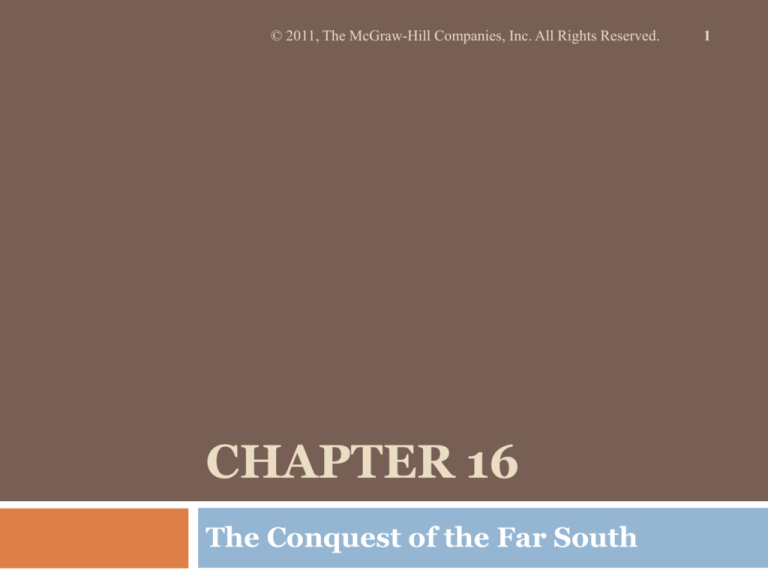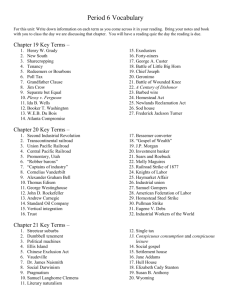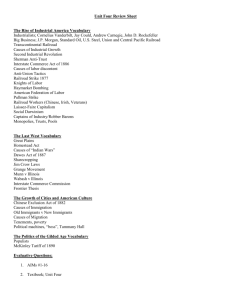
© 2011, The McGraw-Hill Companies, Inc. All Rights Reserved.
CHAPTER 16
The Conquest of the Far South
1
Western Tribes and New Mexico
2
Plains Indians
Lived off hunting buffalo
Used EVERY part of the
Buffalo
….even “buffalo chips”
Unable to unite
Vulnerable to eastern disease
Huge numbers of Hispanics in the
SW
Taos Indian Rebellion
White pop. Shot up after the
expansion of the RRs
http://www.saskschools.ca/~gregory/firstnations/scans/uses.jpg
California and Texas
4
Many Hispanics lived in CA
Whites moved West and took land
They
wouldn’t even let them in the gold mines!
Many Californios were at the bottom of the economic
pyramid
Similar events happened in Texas
The Chinese Migration
5
Over 200,000 Chinese had settled in America by 1880
They were at first welcomed, but then feared
They were driven out of prospecting b/c of:
1. Effect of discriminatory laws
2. hostility of white miners
3. declining profitability of the surface mines
Began to work on the Transcontinental Railroad (for the
Central Pacific).
Very dangerous, brutal conditions
6
Unidentified Artist P1967.727 gelatin silver print, 1919
Central Pacific Railroad Workers. In 1863, Collis P. Huntington,
Leland Stanford, Mark Hopkins and Charles Crocker formed the Big
Four to construct the Central Pacific Railroad. They would hire
12,000-14,000 Chinese to level roadbeds, bore tunnels, blast
mountainsides, and eventually complete the first transcontinental
railroad in 1869
Joining the Tracks for the First
Transcontinental Railroad,Promontory
Point, Utah Newline
Photographer. Andrew J. Russell.
On May 10, 1869, the final gold spike
was driven at Promontory Point.
Dignitaries did not invite Chinese
workers to the official ceremony,
despite their significant contribution
and death toll for the national project.
http://apa.si.edu/ongoldmountain/gallery2/gallery2.html
Chinese Migration
7
After the Transcontinental RR was completed in 1869, many
Chinese moved to cities
Chinatowns
Most Chinese were unskilled laborers, servants or entered into the
laundry business.
Initially, there were very few Chinese women
Why?
Chinese Exclusion Act
Banned immigration for 10 years, barred those in US from becoming citizens
8
Homestead Act 1862
160 acres for 5 years of
cultivating led to mass
migration from south
(exodusters), north,
Europe.
Transportation
advancements
Union/Central Pacific
railroads led to MUCH
easier transport.
1869 took 10 days coast to
coast.
MINING
10
1860-1890s
Boom and Bust cycle
What
Boomtowns:
Denver, CO
VA City, NV
San Francisco, CA
is this?
Men far outnumbered women
What
did most men do after the boom period?
Mining
Railroads were the means to expand
western settlement, mining provided
the motive for many to move west.
Migration happened in “boom” and
“bust” cycles:
1849 –California
1858/59–Colorado
1859 –Nevada’s Comstock Lode
NOTE: Women followed the men and
earned the right to vote out West first:
1869–Wyoming, 1870–Utah, 1893Colorado, 1896-Idaho
San Francisco - 1850
Cattle Kingdom
13
Cattle herding was a Texan and Mexican industry
Americans in Texas adopted their methods
5 million cattle in Texas in 1865, developed Long Drives
What
were long drives?
Sheepmen came from West and created Range Wars
People began to block off their land claims
Sheepmen,
for land
cattlemen, ranchers and farmers all were competing
Romance of the West
14
“True Freedom”
Paintings and
performances
idealized the West
“Buffalo Bill”
The Last Frontier
• Frederick Jackson Turner
• “The frontier has gone and with its going
has closed the first period of American
History.”
Indian “Pacification”
US Govt. signs treaties with Native Americans…..Led to
Reservation System (= Boundaries)
PROBLEM: Ignored reality of migration of tribes, buffalo and
especially settlers
BROKEN PROMISES: US did not respect terms of treaties,
violated its own “boundaries” and failed to provide security
and food to tribes.
16
CONCENTRATION POLICY:
What was it?
How did it benefit the white men?
Forced into Oklahoma and the Dakotas
Buffalo Herds decimated
What happened to the Buffalo?
How did it decimate Native culture?
1865 – 15 million buffalo
1875 – less than one thousand!
Map: Western Indian Reservations, 1890
Western Indian Reservations, 1890
Native-American reservations were almost invariably located on poor-quality lands. Consequently, when the Dawes
Severalty Act broke up the reservations into 160-acre farming tracts, many of the semiarid divisions would not support
cultivation.
Copyright © Houghton Mifflin Company. All rights reserved.
Sand Creek Massacre
November, 1864:
Cheyenne are forced to a barren area of Colorado
Begin to raid local trails for food and supplies
Col. Chivington’s militia massacre approx. 150 women and
children at Sand Creek, CO
"I have come to kill Indians," he is known to have said, "and believe it is right and
honorable to use any means under God's heaven to kill Indians.“ – Col. Chivington
Fighting in the Plains
1866: 81 soldiers & settlers killed Bozeman, MT
1868: Fort Laramie Treaty, govt. abandon’s Bozeman Trail
1874: Col. Custer creates gold rush to Black Hills, SD, sacred to
Sioux. Sitting Bull destroys Custer’s command at Little Big Horn
1877: Nez Perce lands appropriated for gold. Nez Perce flee on
1700 mile trek to Canada. Stopped and sent to Kansas, where
40% died of disease.
Geronimo leads resistance of Apache in South West.
NOTE: 20% of US troops were Buffalo Soldiers
1890: Battle of Wounded Knee
Sioux believed in the Ghost Dance
Wovoka promised a Sioux revival if they performed
this dance
Soldiers arrested about 350 starving and freezing
Sioux and took them to Wounded Knee Creek in S.D.
MASSACRE: Federal Cavalry kills over 300
Ghost Dance
http://php.indiana.edu/~tkavanag/visuale.html
Wounded Knee
Sitting Bull’s death
stems from Ghost
Dance hysteria.
Systematic wiping out
pretty much complete
by end of 19th century.
Dawes Act
1887 Dawes Act Forced Assimilation policies
Reward
good behavior with land and citizenship
1879: Carlisle Indian School,
- “Kill the Indian and Save the man”
- separate children from tribes, educate in - English and
white man’s ways
- Jim Thorpe
Indian population slowly rises after 1890’s.
Dawes Act 1887
Assimilation
Breakup of reservations to agriculture/take
best land for whites
Schools (“kill the Indian, save the man”)
Buffalo wiped out on purpose
“Buffalo Bill” Cody
Battle of Wounded Knee after Sitting Bull’s
death stems from Ghost Dance hysteria.
Indian School
Chapter Seventeen:
Industrial Supremacy
Sources of Industrial Growth
33
• Industrial Technologies
•
•
America was expanding at a rapid
pace
Was becoming the true industrial
power in the world
• Alexander Graham Bell
• Thomas Edison and electric power
• Impact of Electric Power
• Generators and power grids
By the turn of the century,
electricity was everywhere!
Railways, elevators,
factories, homes
The Technology of Iron and Steel Production
34
•
Iron was taking over America
•
•
More than 40,000 mile of RR track had been laid
Bessemer Process
•
•
What was it?
What did it do?
•
Steel industry began in Pittsburgh
•
Close relationship with the RRs
•
Rise of the Petroleum Industry
Pioneer Oil Run, 1865
(Library of Congress)
35
© 2011, The McGraw-Hill Companies, Inc. All Rights Reserved.
The Automobile and the Airplane
36
•
Creation of gasoline and internal combustion engines
opened up new opportunities
•
Henry Ford
•
•
•
•
Creates the first car
1895 – 4 automobiles
1917 – 5 million automobiles
The Wright Brothers
•
•
•
The Wright Brothers
(Library of Congress)
1899 – invented the first airplane
1904 – could fly 23 miles!
1915 – National advisory Committee on Aeronautics is
created
37
George Selden and Henry Ford take a spin in a Selden automobile in New York City, circa 1895. The
two would later go a few rounds in court.
The Science of Production
“Taylorism”
Subdivide
tasks
Made workers
replaceable
Assembly
Line
Both a place and a
concept
What
is the concept of
an assembly line?
38
“Taylorism”
39
Railroad Expansion and the Corporation
40
Railroad was largely responsible for the increase of
business
Why?
1860 – 30,000 miles of track
1900 – 193,000 miles of track
Corporations
What is a corporation?
Limited Liability
Why does this make it easier for
businessmen and investors alike?
Railroad Land Grants
41
Chapter Seventeen:
Industrial Supremacy
42
Railroads, 1870-1890
© 2011, The McGraw-Hill Companies, Inc. All Rights Reserved.
43
© 2011, The McGraw-Hill Companies, Inc. All Rights Reserved.
Tycoons
44
1.
2.
3.
4.
Profiteering from the Civil War gives rise to
millionaire class
Millionaires capitalize on Transcontinental
railroad, mechanization, industrialization, &
expansion of markets
Surplus of raw materials, cheap labor, foreign
investment ENCOURAGE CAPITALISM
Inventions = Industrialization
More Inventions More Industrialization
ALL OF THIS GIVES RISE TO TYCOONS
Andrew Carnegie = Steel Kingpin
45
Steel is King : US pouring out 1/3 of world’s
steel by 1890’s
Carnegie uses vertical integration to make more
profit
Controls all means of production, eliminates middle man
Also uses horizontal integration to eliminate
competition.
Sells to JP Morgan for 450 million
Becomes a philanthropist
How do
horizontal
integration
and vertical
integration
help
business??
J P Morgan – Banker’s Banker
Builds financial empire through railroads,
banks, and holding companies
Buys out Carnegie and enters steel
business
Uses trusts and holding companies to
consolidate wealth and power
What are trusts and holding companies?
Forms US Steel Corporation – 1st ever
corporation worth more than $1 billion!
46
Rockefeller – Standard Oil Corp.
Kerosene and then Automobiles
drive up US oil consumption
Rockefeller ruthlessly uses
horizontal consolidation to create
largest monopoly
1877 controls 95% of US’s oil
refineries
Robber Baron’s Baron
47
Standard Oil Monopoly
Standard Oil Monopoly
Believing that Rockefeller's Standard Oil monopoly was exercising dangerous
power, this political cartoonist depicts the trust as a greedy octopus whose
sprawling tentacles already ensnare Congress, state legislatures, and the
taxpayer, and are reaching for the White House. (Library of Congress)
48
HOW MUCH WOULD THEY BE WORTH TODAY??
J.P. Morgan - $139 BILLION
Andrew Carnegie - $189.6 BILLION
John D. Rockefeller - $262 BILLION
COMPARE:
Bill Gates - $56 BILLION
49
50
Monopoly = a firm that completely controls an industry
Vertical integration = combining all phases of manufacturing in to one
organization (Carnegie)
Horizontal consolidation = allying with competitors to monopolize a market
(Rockefeller)
Trust = a board of directors/stockholders that coordinates companies
within an industry to avoid competition
Holding company = a corporation composed of various competing
enterprises within one industry (JP Morgan’s US Steel)
Justifications for Big Business
51
Old Rich displaced by rule of the “new rich”
Gospel of Wealth – discourages helping the poor
by state
Laissez faire = “let it be”
Justified by Social Darwinism – survival of the
fittest
Poor are poor due to lack of initiative
Horatio Alger
What did Alger do to justify this?
The Problems of Monopoly
52
o Economic Concentration Challenged
o Gained momentum in society
o Complaints that they could charge
whatever they wanted
o Contributed to instability
Immigrant Workforce
53
Rapidly Expanding Working Class
Where are they coming from?
Labor Contract Law
What is this?
Growing Ethnic Tensions
Inspection room at Ellis Island, NY
(Library of Congress)
54
© 2011, The McGraw-Hill Companies, Inc. All Rights Reserved.
Impact of Industrialization
Urbanization
55
Long Work Hours and Dangerous Jobs
Children work too
Women’s roles change
Accentuated class division
Delayed marriages
Smaller families
1900: 1/10 of US owns 9/10 of US’s wealth
1900: 2/3 of Americans are “wage slaves”
Workers’ lives increasingly precarious
Workers’ Poor Conditions
Factories took the skill out of many
positions
VERY dangerous
1882 – 675 laborers killed
RRs – 1 in 300
Many women and children worked
to make ends meet
Children sacrificed their education
1899 – women earned $269 a
year/men earned $498
That same year Carnegie made $23
million!!
56
Knights of Labor
Collective effort needed to counter
trusts
“An injury to one is an injury to all”
Founded as a secret society in
1869. Why?
Inclusive and Diverse:
men and women
white and black
skilled and unskilled
Broad (utopian? Socialist?) goals
HURT by Haymarket Square riot,
1886, Chicago
Knights of Labor
Black delegate Frank J. Farrell introduces Terence
V. Powderly, head of the Knights of Labor, at the
organization's 1886 convention. The Knights were
unusual in58
accepting both black and female
workers. (Library of Congress)
American Federation of Labor
60
Skilled workers split from Knights of Labor
1886
AFL was elitist, narrow in goals – not utopian
Led by Samuel Gompers
Avoided politics and focused on union goals:
Better wages
Eight-hour day
Better working conditions
AFL successful in many of its strikes and in
meeting many of its goals
63
The Knights of Labor were weakened by
1.
a.
b.
c.
d.
Its refusal to endorse social reform and the 8 hour day
Stiff competition from the National Labor Union
Its association in the public mind with the Haymarket riot
Its inclusion of both skilled and unskilled workers
Strikes Turn Violent
65
ttp://www.edteck.com/dbq/dbquest/quest11.htm
STRIKES
GREAT STRIKE
OF 1877
HAYMARKET
AFFAIR
1886
HOMESTEAD
STRIKE
1892
66
PULLMAN STRIKE
1893
STRIKES
RAILROAD STRIKE
OF 1877
**Pullman Strike – NBC Learn video
HAYMARKET
BOMBING
1886
Railroad strike
Paralyzed rail
& commerce
Labor march
Bomb thrown
Several deaths
Pres. Hayes
Sent US troops
to end it
8 Anarchists
arrested
4 hanged,
1 suicide
CHINESE
PUBLIC TURNS
EXCLUSION ACT
AGAINST
LABOR
HOMESTEAD
STRIKE
1892
STEEL STRIKE
Protest work
& living
conditions
Pinkerton
Detectives
protect scabs,
Several deaths
US troops end it
WEAKENS
67
LABOR
PULLMAN STRIKE
1894
Pullman Comp.
cuts wages
during Panic
of 1894
Does not raise
after ends
Workers strike
US troops end it
Debs arrested
Workers
Blacklisted
LABOR WEAK
1877 and Homestead Strikes
Sources of Labor Weakness
71
Wages barely went up
Won some legislative victories
But
most of them were not even enforced!
Most workers had LESS power than they used to
Why?
Division
in the workforce
Many workers on the move
Corp. usually had state, local or fed. Help
72
The Age of the City
CHAPTER 18
Total Immigration, 1861-1900
73
© 2011, The McGraw-Hill Companies,
Inc. All Rights Reserved.
The Age of the City
Urbanization
1850: 3.5 million in
urban areas
1900: 30.2 million in
urban areas
Baltimore 1850
Baltimore 1910
The Ethnic City
The Diverse Immigrant Populations
Lived in ghettos together
Why did this make it easier to adjust?
Importance of Ethnic Ties
Felt more comfortable
Continued traditions
Advanced in society
76
Assimilation and Exclusion
Assimilation Encouraged
Mainly English
Stores sold American food and clothing
Immigration Restriction League
Screen immigrants through literacy tests
“desirable” and “undesirable”
What was the benefit to so much immigration?
77
“Immigration Under Attack,” 1903
78
(New York Public Library. Astor, Lenox and Tilden Foundations)
Ellis Island
80
© 2011, The McGraw-Hill Companies,
Inc. All Rights Reserved.
Public Space
• Built to represent something different than a city
• Libraries, parks, theaters
• Who supported the construction of these projects?
The Mall in Central Park, 1902 (Library of Congress)
81
The Search for Housing
Railroad Suburbs
What is a railroad
suburb?
Jacob Riis
What impact did Riis have
on society?
Attic tenement house
(Library of Congress)
82
Housing Conditions
86
© 2011, The McGraw-Hill Companies,
Inc. All Rights Reserved.
Strains of Urban Life
87
Fire
Began
to build fireproof
buildings
Many new skyscrapers were built
b/c of fires
Disease
Typhoid
fever and cholera
No sophisticated toilet system
Great Chicago fire of 1871
Environment and Violence
88
Air pollution
Sewage Disposal Systems
Poverty
“deserving” v. “undeserving”
Private organizations
Violence
1880 – 25 murders for every 100 people
1900 – 100 murders for every 100 people
The Machine and the Boss
89
How did the political machine help immigrants?
Often were vehicles for making money
“Boss” Tweed
Rise of Mass Consumption
90
Incomes rise throughout the late 19th century
Whose income rose the most?
Ready-made clothing
Buying then preparing food
Tin cans, refrigerated railroad cars
Women were becoming more into fashion
Chain stores, dept. stores, and mail-order
catalogs were increasing in popularity
Leisure in Society
91
With shorter hours and higher wages, people were enjoying
their leisure time
Baseball becomes popular after the Civil War
Cincinnati
Red Stockings were first pro team
1891 – James Naismith invents basketball
1869 - First football game: Princeton v. Rutgers
Leisure in Society
92
Music, Theatre and
Movies
Vaudeville
D.W. Griffith
Birth
of a Nation
Hammerstein Theatre, NYC
Coney Island
93
Why were people so
attracted to amusement
parks?
Dime Novels
Newspaper popularity
William Randolph Hearst
Telephones
At first they were
impractical
Switchboard
Mostly owned by businesses
Coney Island, NY
Impact of Darwinism
94
What is Darwinism?
How did it impact city/rural lives?
Pragmatism
Society
should rely on science, not religion
This sparked new ideas on schooling
(democratic method), economic impacts on
society and anthropology
Public schooling gained added importance
Universities grew through donations
95
Many schools began to focus on discoveries in agriculture,
mechanics, and medicine
Medical Advancements
X-ray
Identifying infections
Blood transfusions
What did this do?
Germ Theory Accepted
How did this change medicine?
© 2011, The McGraw-Hill Companies, Inc. All Rights Reserved.
CHAPTER 19
From Crisis to Empire
96
Politics of Equilibrium
97
The Party System
Stability and Stalemate
Little changed in the Rep. and Dem. Parties
High Turnout
78% of eligible voters turned out 1860-1900
Who voted Democrat? Why?
Republican? Why?
Politics of Equilibrium
98
Nat. Govt. Didn’t do much
Collected taxes, foreign policy, mail, military, civil war pension
Presidents and Patronage
Rutherford B. Hayes
Stalwarts and Half-Breeds
Election of 1880
Garfield wins
July 2, 1881 – Garfield assassinated
Chester A. Arthur is president
Pendleton Act
What did the Pendleton Act do?
The Politics of Equilibrium
99
– Cleveland, Harrison, and the Tariff
1884
Grover Cleveland Elected
Tough on crime, corruption and
politics
1888
Harrison defeats Cleveland
What was unique about this
election?
Grover Cleveland
1892
Cleveland defeats Harrison….
(Library of Congress)
New Public Issues
100
Public opinion was forcing Harrison to act
Sherman Antitrust Act
Tried to limit corporations. Not very successful.
McKinley Tariff
Why were people angry about this?
Interstate Commerce Act
Made all RR rates “reasonable and just”
Populism
101
Farmers ally themselves against the Railroads
Why?
July 1892 – People’s Party (Populism) created
Immediately gained seats in govt. but their potential was limited.
Populist Ideas
Ocala Demands
Allow farmers to borrow money with low interest
Abolition of National Banks
Direct election of Senators
Govt. ownership of RRs, telephones, and telegraphs
Crisis of the 1890s
102
– The Panic of 1893
America’s Interconnected Economy
Railroads, banks, loan dependent businesses….
Within 8 months 8,000 businesses, 156 RRs, and 400
banks failed.
“Coxey’s Army”
What is Coxey’s Army?
– The Silver Question
“Bimetallism”
“Crime of 73”
What was the crime of 73? How does this affect farmers?
“A Cross of Gold”
William McKinley elected as the Republican candidate
“A Cross of Gold”
Having behind us the commercial interests and the
laboring interests and all the toiling masses, we
shall answer their demands for a gold standard by
saying to them, you shall not press down upon the
brow of labor this crown of thorns. You shall not
crucify mankind upon a cross of gold.
Bryan nominated for the Democrats
Why are the populists annoyed?
“Fusion”
What is Fusion? Why did the Populists
agree to it?
William McKinley
(Library of Congress)
NBC Learn:
“Free Silver”
Conservative Victory
104
Birth of modern campaigning
Bryan traveled 18,000 miles and
addressed an estimated 5 million
people!
End of the People’s Party
They gambled on Bryan and lost…
Gold Standard Act
Confirmed the nation’s commitment to the
gold standard
More gold was discovered and the
amount of gold in the economy was
almost tripled, this alleviated concerns
for bimetallism.
Election of 1896
Stirrings of Imperialism
105
The “end of Manifest Destiny”
caused some to look abroad
Provided new markets
Americans felt it natural to exert control
over other weaker nations
Alfred Thayer Mahan
Influence of Sea Power Upon History
Most powerful countries are strong in
the sea
Screen clipping taken: 3/2/2011, 11:01 AM
First Conquest…Hawaii
1790: Americans first arrive in Hawaii, eventually
become very connected to Hawaiian trade
1891: Queen Lilioukalani of Hawaii proposes removing rights of
non-native Hawaiians…why?
1893: Americans lead a revolution and take control
Why was it in Hawaii’s best interest to become a
state?
American businessman Sanford Dole becomes President
1898: Congress annexes Hawaii
108
© 2011, The McGraw-Hill Companies, Inc. All Rights Reserved.





